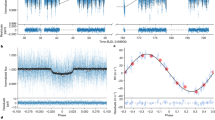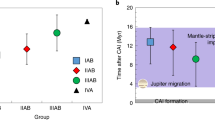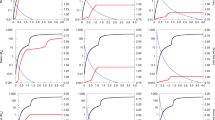Abstract
Iron meteorites are core fragments from differentiated and subsequently disrupted planetesimals1. The parent bodies are usually assumed to have formed in the main asteroid belt, which is the source of most meteorites. Observational evidence, however, does not indicate that differentiated bodies or their fragments were ever common there. This view is also difficult to reconcile with the fact that the parent bodies of iron meteorites were as small as 20 km in diameter2,3 and that they formed 1–2 Myr earlier than the parent bodies of the ordinary chondrites4,5,6. Here we show that the iron-meteorite parent bodies most probably formed in the terrestrial planet region. Fast accretion times there allowed small planetesimals to melt early in Solar System history by the decay of short-lived radionuclides (such as 26Al, 60Fe)7,8,9. The protoplanets emerging from this population not only induced collisional evolution among the remaining planetesimals but also scattered some of the survivors into the main belt, where they stayed for billions of years before escaping via a combination of collisions, Yarkovsky thermal forces, and resonances10. We predict that some asteroids are main-belt interlopers (such as (4) Vesta). A select few may even be remnants of the long-lost precursor material that formed the Earth.
This is a preview of subscription content, access via your institution
Access options
Subscribe to this journal
Receive 51 print issues and online access
$199.00 per year
only $3.90 per issue
Buy this article
- Purchase on Springer Link
- Instant access to full article PDF
Prices may be subject to local taxes which are calculated during checkout



Similar content being viewed by others
References
Burbine, T. H., McCoy, T. J., Meibom, A., Gladman, B. & Keil, K. in Asteroids III (eds Bottke, W. F. et al.) 653–667 (Univ. Arizona Press, Tucson, 2002)
Mittlefehldt, D. W., McCoy, T. J., Goodrich, C. A. & Kracher, A. in Planetary Materials (ed. Papike, J. J.), Rev. Mineral. 36, 4-1–195 (1998).
Chabot, N. L. & Haack, H. in Meteorites and the Early Solar System II (eds Lauretta, D. S. & McSween, H. Y.) (Univ. Arizona Press, Tucson, in the press)
Kleine, T., Mezger, K., Palme, H. & Scherer, E. Tungsten isotopes provide evidence that core formation in some asteroids predates the accretion of chondrite parent bodies. Lunar Planet. Sci. Conf. 36, 1431–1432 (2005)
Baker, J., Bizzarro, M., Wittig, N., Connelly, J. & Haack, H. Early planetesimal melting from an age of 4.5662 Gyr for differentiated meteorites. Nature 436, 1127–1131 (2005)
Bizzarro, M., Baker, J. A., Haack, H. & Lundgaard, K. L. Rapid timescales for accretion and melting of differentiated planetesimals inferred from 26Al-26Mg chronometry. Astrophys. J. 632, L41–L44 (2005)
Russell, S. S. et al. Evidence for widespread 26Al in the solar nebula and constraints for nebula time scales. Science 273, 757–762 (1996)
Srinivasan, G., Goswami, J. N. & Bhandari, N. 26Al in eucrite Piplia Kalan: Plausible heat source and formation chronology. Science 284, 1348–1350 (1999)
Sanders, I. S. & Taylor, G. J. in Chondrites and the Protoplanetary Disk (eds Krot, A. N. et al.) 915–932 (ASP Conf. Series 341, Astron. Soc. Pacific, San Francisco, 2005)
Bottke, W. F., Vokrouhlický, D., Rubincam, D. P. & Brož, M. in Asteroids III (eds Bottke, W. F. et al.) 395–408 (Univ. Arizona Press, Tucson, 2002)
Levison, H. F. & Agnor, C. The role of giant planets in terrestrial planet formation. Astron. J. 125, 2692–2713 (2003)
Bottke, W. F. et al. Debiased orbital and absolute magnitude distribution of the near-Earth objects. Icarus 156, 399–433 (2002)
Gradie, J. & Tedesco, E. Compositional structure of the asteroid belt. Science 216, 1405–1407 (1982)
Petit, J., Morbidelli, A. & Chambers, J. The primordial excitation and clearing of the asteroid belt. Icarus 153, 338–347 (2001)
Gomes, R., Levison, H. F., Tsiganis, K. & Morbidelli, A. Origin of the cataclysmic Late Heavy Bombardment period of the terrestrial planets. Nature 435, 466–469 (2005)
Gladman, B. J. et al. Dynamical lifetimes of objects injected into asteroid belt resonances. Science 277, 197–201 (1997)
Grimm, R. E. & McSween, H. Y. Heliocentric zoning of the asteroid belt by aluminum-26 heating. Science 259, 653–655 (1993)
Weidenschilling, S. J. The distribution of mass in the planetary system and solar nebula. Astrophys. Space Sci. 51, 153–158 (1977)
Greenberg, R., Hartmann, W. K., Chapman, C. R. & Wacker, J. F. Planetesimals to planets—Numerical simulation of collisional evolution. Icarus 35, 1–26 (1978)
Stevenson, D. J. & Lunine, J. I. Rapid formation of Jupiter by diffuse redistribution of water vapor in the solar nebula. Icarus 75, 146–155 (1988)
Scott, E. R. D. in Asteroids III (eds Bottke, W. F. et al.) 697–709 (Univ. Arizona Press, Tucson, 2002)
Bus, S. J. & Binzel, R. P. Phase II of the small main-belt asteroid spectroscopic survey: The observations. Icarus 158, 106–145 (2002)
Lazzaro, D. et al. Discovery of a basaltic asteroid in the outer main belt. Science 288, 2033–2035 (2000)
Sunshine, J. M. et al. High-calcium pyroxene as an indicator of igneous differentiation in asteroids and meteorites. Meteorit. Planet. Sci. 39, 1343–1357 (2004)
Cellino, A., Bus, S. J., Doressoundiram, A. & Lazzaro, D. in Asteroids III (eds Bottke, W. F. et al.) 632–643 (Univ. Arizona Press, Tucson, 2003)
Bottke, W. F. et al. The fossilized size distribution of the main asteroid belt. Icarus 175, 111–140 (2005)
Bottke, W. F. et al. Linking the collisional evolution of the main belt to its dynamical excitation and depletion. Icarus 179, 63–94 (2005)
Bottke, W. F., Nolan, M. C., Greenberg, R. & Kolvoord, R. A. Velocity distributions among colliding asteroids. Icarus 107, 255–268 (1994)
Bottke, W. F. et al. in Dynamics of Population of Planetary Systems (IAU Colloquium 197, Belegrade, 357–376) (eds Knezevic, Z. & Milani, A.) (Cambridge Univ. Press, Cambridge, 2005)
Eugster, O. Cosmic-ray exposure ages of meteorites and lunar rocks and their significance. Chemie Erde 63, 3–30 (2003)
Acknowledgements
We thank S. Bus, J. Chambers, D. Durda, M. Gounelle, H. Haack, H. Levison, T. McCoy, D. Mittlefehldt, E. Scott, J. Sunshine, D. Vokrouhlicky and M. Zolensky for discussions and comments. The project was supported by NASA's Origins of Solar System and Planetary Geology and Geophysics programmes.
Author information
Authors and Affiliations
Corresponding author
Ethics declarations
Competing interests
Reprints and permissions information is available at npg.nature.com/reprintsandpermissions. The authors declare no competing financial interests.
Supplementary information
Supplementary Discussion
This file contains an extended discussion of several issues that could not be addressed in the main text. There are two Supplementary Figures. Supplementary Figure 1 shows the delivery efficiency of test bodies from various main belt resonances striking the Earth. Supplementary Figure 2 shows how a hypothetical population of olivine-rich A-type asteroids placed in the inner main asteroid belt undergo collisional and dynamical evolution. (PDF 919 kb)
Rights and permissions
About this article
Cite this article
Bottke, W., Nesvorný, D., Grimm, R. et al. Iron meteorites as remnants of planetesimals formed in the terrestrial planet region. Nature 439, 821–824 (2006). https://doi.org/10.1038/nature04536
Received:
Accepted:
Issue Date:
DOI: https://doi.org/10.1038/nature04536
This article is cited by
-
Nitrogen isotopic ratio and abundance in selected ordinary chondrites: clues for their formation in proto-planetary disk
Astrophysics and Space Science (2023)
-
Bulk and in-situ chemical analysis of meteorite Berduc, an L6 chondrite
Journal of Earth System Science (2023)
-
Distinguishing the Origin of Asteroid (16) Psyche
Space Science Reviews (2022)
-
Common feedstocks of late accretion for the terrestrial planets
Nature Astronomy (2021)
-
Planetesimal rings as the cause of the Solar System’s planetary architecture
Nature Astronomy (2021)
Comments
By submitting a comment you agree to abide by our Terms and Community Guidelines. If you find something abusive or that does not comply with our terms or guidelines please flag it as inappropriate.



